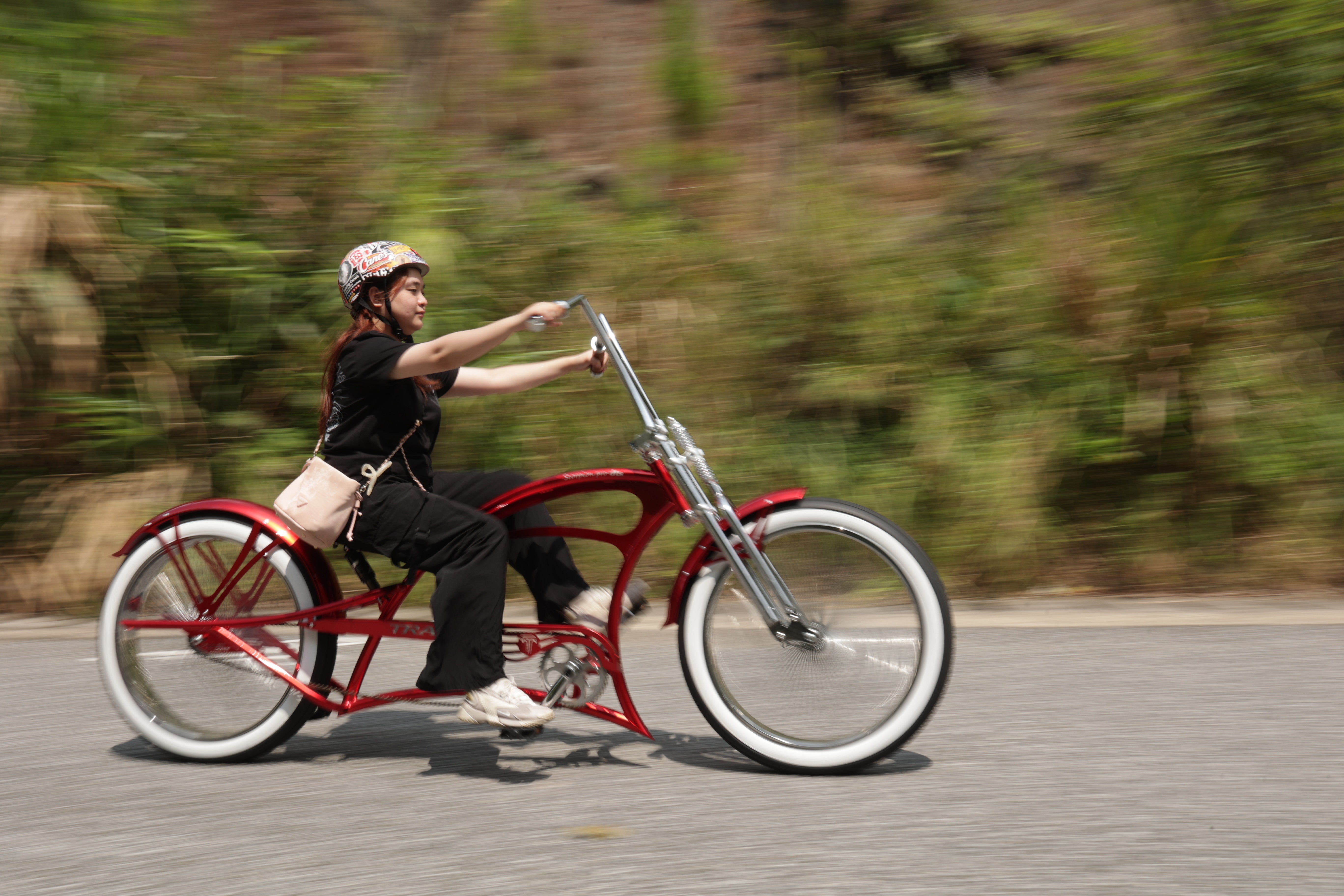Introduction
Increasing cycling power helps you ride faster, tackle hills, and improve performance—whether commuting, cruising, or riding an e-cruiser. You don’t need to be a pro; smart training builds stronger legs, more power, and better endurance.
In this guide, we’ll share five practical strategies to help you increase cycling power. These apply to all kinds of bikes—from traditional road and city bikes to stretch cruisers and fat-tire e-bikes—and suit riders of all levels. Let’s roll.
1. Ride in Bigger Gears (and Hold the Cadence)
A simple and effective way to boost cycling power is to ride in a bigger gear while keeping your cadence steady.
Why it works:
Using a harder gear forces your muscles to generate more force with each pedal stroke, increasing torque and overall power. This strengthens your legs and improves endurance more effectively than pedaling faster in an easier gear.
How to apply it:
- On flat or gently rolling terrain, shift one or two gears harder than usual.
- Maintain your normal cadence (around 80–90 rpm) for 2–4 minutes.
- Return to your usual gear for 2–4 minutes of recovery.
- Gradually extend the time in the harder gear as your strength improves.
- Stretch-cruiser riders: Sit upright, shift into a bigger gear, and focus on smooth, consistent strokes. For example the Raider Pro DS7 with Shimano 7-speed gearing ensures effortless transitions even when riding in harder gears.
Pro tips:
- Keep cadence above ~70 rpm to maintain efficiency.
- Limit to 2–3 sessions per week to allow recovery.
- Combine with regular endurance rides for balanced training.
Further Reading: Understanding Different Types of Bike Gears and Their Uses
2. Attack Hills or Ride into the Wind
Hills and headwinds are natural ways to boost your cycling power. Climbing or pushing through wind forces your muscles to work harder, improving both strength and endurance.
Why it works:
Climbing or riding into wind forces you to push harder with each stroke, increasing force and power. Your aerobic and muscular systems both adapt.
How to apply it:
- Choose a hill where you can ride 60–90 seconds uphill with moderate effort, recover descending, then repeat for 4–8 efforts.
- If you’re on flat terrain, work a loop so you regularly face headwinds. Aim to pedal hard through the wind section, then recover when tailwind returns.
- Use a bigger gear than your usual to maintain force.
Pro tips:
- Warm up for 10 minutes before starting intervals.
- After the efforts, spin easy for a few minutes to flush fatigue.
- Limit this type of workout to 1 session per week if you’re also doing other power work—recovery matters.
Further Reading: How to Prepare for a Long-Distance Bike Ride
3. Strength Training Off the Bike
Building cycling power isn’t just about riding—it also depends on muscle strength and coordination. Targeted off-bike strength work helps you generate more force and sustain power on every pedal stroke.
Why it works:
Cycling is low-impact, so your muscles don’t naturally get heavy loads. Strength exercises develop fast-twitch fibers and improve neuromuscular coordination, allowing you to pedal harder and more efficiently.
How to apply it:
- Two times per week include a strength session with:
- Squats or leg presses
- Deadlifts or single-leg deadlifts
- Lunges
- Core work (planks, Russian twists)
- Use moderate to heavy weights (4–8 reps), focusing on control over volume.
Pro tips:
- For cruisers and upright bikes: include exercises for glutes, hips and lower back to support posture and pedal efficiency.
- Avoid excessive volume; balance strength days with recovery rides.
4. Structured Interval Training
Structured interval workouts are one of the most effective ways to boost cycling power. Short, intense efforts followed by recovery train both your anaerobic system and neuromuscular coordination.
Why it works:
Intervals push your muscles to generate high power, improving recruitment efficiency, increasing watt output, and enhancing fatigue resistance over time.
How to apply it:
- Warm up for ~10 minutes.
- Choose an interval format like:
- 30 seconds at maximum effort (~150% of your usual cadence/force)
- 60 seconds recovery
- Repeat 4-6 times
- Cool down for 10 minutes.
- Another option: 4×4 minutes at 90–95% of threshold power, with equal recovery.
Pro tips:
- Use a power meter or smart trainer if you have one; if not, go by “hard but controlled” effort.
- Limit to 1-2 interval sessions per week. Balance with endurance rides.
- Track your progress—average power should gradually increase for same effort level.
Bike Highlight: The Twenty5 GT 26" Electric Cruiser is ideal for interval training. With its 5-speed motor assistance and 3 pedal-assist modes, you can safely push harder during efforts and recover comfortably.
5. Smart Recovery and Consistency Matter
One of the most overlooked ways to increase cycling power is training smart—not just more. Recovery and consistency are key to building strength and endurance.
Why it works:
Power gains happen when muscles rebuild and adapt during rest. Overtraining or skipping recovery reduces progress.
How to apply it:
- Plan your training week:
- ~70–80% of time at moderate pace (Zone 2)
- ~10–20% high intensity (hill work, intervals)
- 1–2 rest or active-recovery days (easy spin or off-bike).
- Prioritize 7–9 hours quality sleep nightly.
- Track fatigue, sleep quality, and mood. If you feel flat, ease off.
- Use recovery rides: 30–60 minutes at light pace, focusing on smooth pedal stroke and mobility.
Pro tips:
- For stretch cruiser riders: power gains don’t always mean racing—they mean easier, smoother, and more comfortable riding.
- Incorporate cadence drills to improve pedaling efficiency and overall power.
Further Reading: Essential Safety Tips for Riding Your Bike in Traffic
Bringing It All Together: Your 4-Week Intro Power Plan
Here’s a simple plan you can follow to begin increasing cycling power:
|
Week Plan |
|
|
1 |
2 moderate rides (45 min each), 1 bigger-gear ride (20 min), 1 strength session |
|
2 |
1 interval session (30 s efforts), 1 hill/wind session, 1 bigger-gear ride, 1 strength session, 1 easy spin |
|
3 |
1 interval session (4×4 min or 6×30 s), 1 hill session, 1 strength, 2 moderate rides |
|
4 |
Deload week: 2 easier rides, 1 bigger-gear ride, 1 strength session at lighter load |
Conclusion
Increasing cycling power doesn’t require endless miles or pro-level genetics — it’s all about smart training, consistency, and proper recovery. By riding in harder gears, tackling hills or headwinds, adding off-bike strength work, performing structured intervals, and prioritizing recovery, you can achieve noticeable gains in strength, speed, and endurance.
Start today: pick one tip, plan your next ride, and feel the difference. Ride stronger, ride smarter, and enjoy every pedal stroke.
FAQs
Q1: Do I need a power meter?
No. You can increase power using perceived effort, cadence, and heart-rate zones. A power meter helps, but it’s not required.
Q2: Will I have to ride flat out all the time?
No. More power means easier riding, better climbs, and more comfortable pacing—not constant sprinting.
Q3: Does this apply to cruisers and e-bikes?
Yes. Power training helps all riders, making pedaling easier and rides more enjoyable.
Q4: How long to see results?
With smart, consistent training, noticeable gains appear in 4–8 weeks.



Share:
Cruiser Bikes Lifestyle: Your Ultimate Guide to Style and Comfort
Ride in Comfort: The Ultimate Guide to Adjusting Your Bike Seat for Perfect Posture